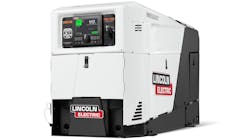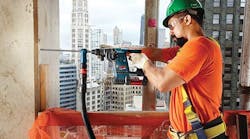CHICAGO — Some say that it’s a contractor’s best friend — a tool, that is. There might not be a more trusted contractor ally than a durable, reliable and powerful set of tools in that toolbag.
CONTRACTOR magazine recently conducted its annual power tool survey, and the results are in. Some quick numbers reveal that of the respondents — nearly half of which own their own business with an estimated mean of 47 employees — 80 percent claimed that they perform residential work, 68 percent say commercial, and of that, 70 percent work in the remodeling/retrofit industry.
According to the survey, the mean estimated annual expenditure on power tools is close to $15K, showing the commitment to continued heavy investment in power tools.
“The investment contractors make in power tools can be substantial and the value those tools provide continue to evolve with improvements in technology,” said Corey Dickert, vice president of Product Management, Milwaukee Tool.
And with that investment comes great potential. “Contractors are trying to find ways to save time and money in an effort to increase profits in a very competitive market; therefore, they are looking for new innovations in the space to gain a competitive advantage,” said Dave Pizzolato, group manager, Robert Bosch Tool Corporation.
In any event, it’s always interesting to get a better understanding of the who, what, why and where of contractor tool usage. One thing is for sure, “users are clear about what they want: more power, greater runtime and greater versatility,” said Todd Plajzer, senior product manager for Professional Power Tools, DeWalt, who specializes in the plumbing, hydronic and HVAC categories.
Corded vs. cordless
Our survey suggests that those surveyed push their corded tools hard with medium to heavy usage, while cordless tools were used more on the light to medium side. Regardless, there will always be a spirited debate — in the back of shops, in chat rooms or right from the field — as to whether what type of tool — corded vs. cordless — is best suited for the jobsite. There are still contractors who remain adamant about their corded tools, and believe these products are better for certain applications. While that may have been true in years past, the market has been completely disrupted by the battery pack. The breadth of tools offered in a cordless platform, the warranty provided, after sales service and overall performance on the job are just a few of the considerations when making an investment in a power tool platform.
Contractors are performing more diverse work than ever before — as indicated in the survey with HVAC, hydronics, radiant floor heating and plumbing dominating the replies regarding type of work being done. Simple heating systems have evolved into a hybrid of electrical plumbing and mechanical work, and this has called for a great deal of additional tools.
“Thus strengthening the position of cordless tool platforms like M18, for example, can provide contractors with an array of tools to accomplish these installation processes — backward and forward compatible with any M18™ battery,” said Dickert.
But battery technology isn’t just pushing the boundaries of traditional power tool performance it’s advancing other crucial areas such as lighting, for example.
Much of the lighting seen on jobsites today, said Dickert, is tethered to a power cord, requiring users to lay out extension cords and maneuver for limited power on the jobsite. Managing power cords alone can be a drain on productivity. Additionally, during critical times when there is no power, users can be left without light.
The silica standard
Heavy usage in drilling, regardless of corded or cordless, dominated the results in this year’s survey. Topical and trending for today’s jobsite, for professionals who drill, chisel or cut concrete, the U.S. Department of Labor’s Occupational Safety and Health Administration (OSHA) recently issued a ruling that reduces permissible worker exposure to respirable silica dust averaged over an eight-hour period to 50 micrograms — about 1/20th the size of a grain of salt), reports Bosch’s Pizzolato. OSHA will review and penalize companies for non-compliance; enforcement begins as early as Sept. 23, 2017, for most states.
“Jobsite managers looking to move toward compliance and help protect workers who use power tools, effective dust management can be maximized by the combination of the correct tool, accessory/attachment and dust extractor all working together,” said Pizzolato.
In addition, many applications require respiration; all products in that process need to be optimized for maximum dust extraction.
“Power tools from Bosch, along with attachments, hoses and vacuums, are designed to remove airborne dust efficiently,” continued Pizzolato.
Battery advancements
Large format battery innovations are benefiting the power tools market, said Sharmela Budhu, senior product managers for Professional Power Tools, DeWalt, and larger cells are capable of storing much more energy than their smaller counterparts. “We will start to see the watt hours of batteries continue to get higher in the next few years,” said Budhu.
Industry and user focus is on battery advancements that deliver more power and greater runtime.
“For example, the new Bosch CORE18V battery offers maximum power and performance at minimum weight. This battery employs new high-density cells, an advanced Lithium-ion technology to deliver 80 percent more power than previous generation Bosch batteries,” said Pizzolato.
“Challenges on the jobsite such as battery runtime, portability and overall performance are being addressed every day as cordless technology improves,” said Dickert.
This investment in technology has also unlocked capabilities the industry never thought possible. “The capability to not only deliver traditional productivity realized when using cordless tools, but also provide additional value to the contractor that was never possible due to technology limitations,” continued Dickert.
New technology
With changes in workflow brought on by the Internet of Things, and software that’s improving efficiency in buildings, the installation tooling and services offered by manufacturers have needed to evolve as well.
“Contractors look to manufacturers to give them an edge. We recognized these changing trends several years ago and began developing the systems to provide cost effective solutions for contractors,” said Dickert.
Built on the principles of customize, track, and manage, Milwaukee’s ONE-KEY, for example, is the first digital platform for tools and equipment. The platform combines tool and software technology to develop a tool management solution that provides a more productive way for work to get done in any size company.
In the end it is clear that contractors are married to their tools, and they expect them to perform efficiently — with enough power — be durable and reliable.
“In general, users want tools that help them get their tasks done quickly, with enough battery life, and in a safe and user-friendly manner,” said Plajzer.




